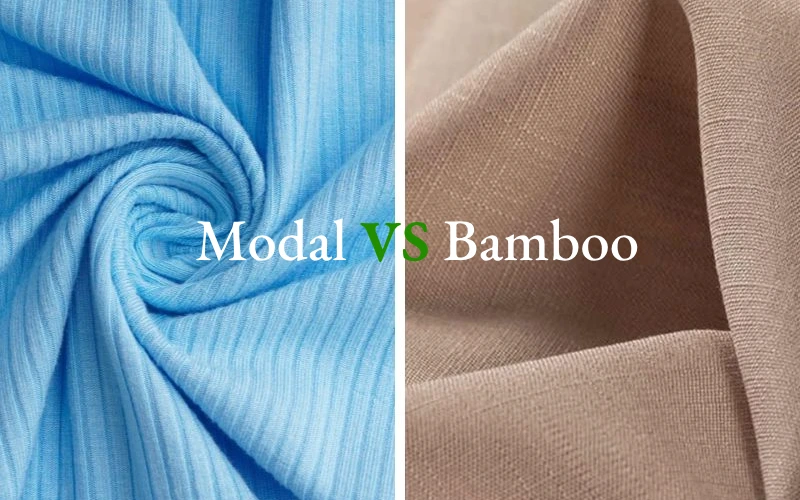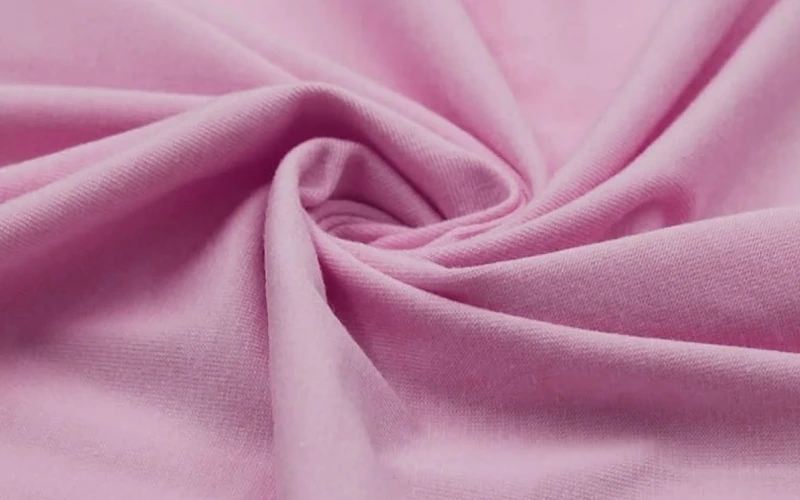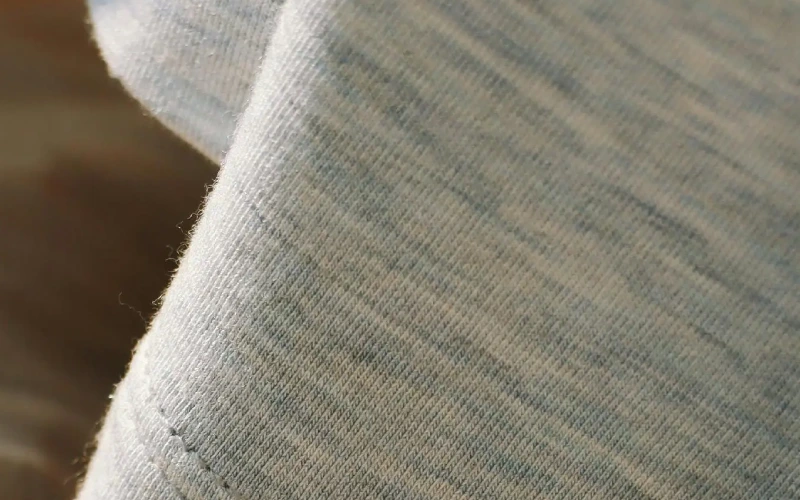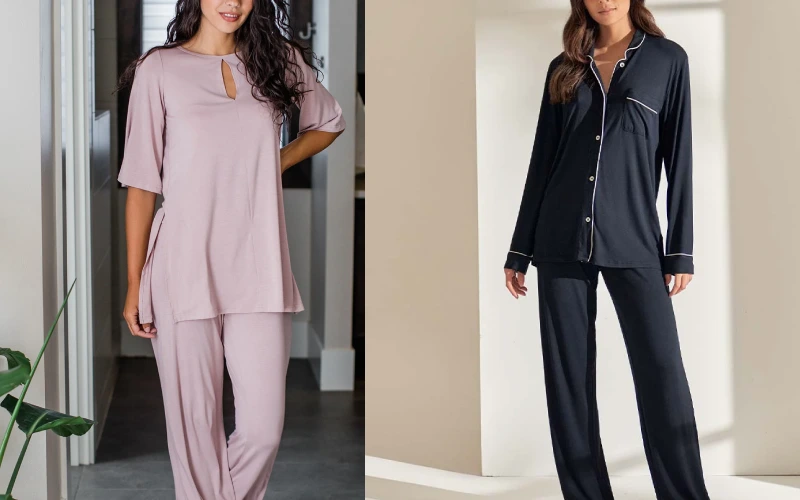In today’s world, choosing the right fabric for pajamas isn’t just about comfort—it’s about making smarter, more sustainable choices. As a pajama manufacturer with over a decade of hands-on industry experience, we’ve seen the trends evolve from polyester blends to eco-conscious alternatives. Customers today are not only asking “How does it feel?”—they’re asking “Where did it come from?”

When it comes to sustainability and softness, two fabrics stand tall: Modal and Bamboo. These two are frequently pitted against each other, but the truth is more nuanced. They each bring something unique to the pajama party. Whether you’re a wholesaler looking to make a bulk decision or an end-user who’s tired of scratchy nightwear, this guide dives deep into Modal vs Bamboo from a technical, emotional, and real-life pajama-wearing perspective.
What is Modal?

How Modal is Made
Modal is a type of rayon—a semi-synthetic fiber—originating primarily from beech tree pulp. The manufacturing process involves turning wood chips into cellulose, which is then spun into yarn. This method uses a closed-loop process to reduce waste, but it still involves chemicals such as sodium hydroxide and carbon disulfide.
According to Wikipedia, Modal is considered more environmentally friendly than traditional viscose due to higher fiber yield per acre and the reusability of the solvents. The end result is a smooth, luxurious fabric that feels like silk, but behaves like cotton.
Benefits of Modal Fabric
If you’ve ever worn pajamas that made you want to stay in bed all day, chances are they were made from Modal. Its key benefits include:
- Exceptional softness – almost buttery against the skin.
- High breathability – great for warmer climates or sweaty sleepers.
- Wrinkle resistance – your pajamas look polished right out of the dryer.
- Color retention – dyes adhere beautifully, even after multiple washes.
- Stretch and drape – hugs your body in all the right ways without feeling tight.
Challenges and Limitations of Modal
Despite its dreamy texture, Modal isn’t without its downsides:
- Prone to pilling – especially under frequent friction.
- Chemical-intensive production – even with improvements, it’s not entirely natural.
- Lower structural integrity compared to cotton or linen – can wear thin over time if not blended.
These limitations are important for us as manufacturers, because we always weigh softness against long-term wearability and customer expectations.
What is Bamboo Fabric?

Bamboo Rayon vs Bamboo Linen: Key Differences
Bamboo fabric generally falls into two categories: Bamboo Rayon (or viscose) and Bamboo Linen. Rayon from bamboo is chemically processed using solvents like sodium hydroxide to break down bamboo pulp into fibers. Bamboo linen, on the other hand, is mechanically processed and much more labor-intensive—thus, rare and expensive.
As per textile experts and the Textile Exchange Standards, Bamboo Rayon is the most common form you’ll find in pajamas due to its softness, affordability, and availability in large quantities for mass production.
Benefits of Bamboo Fabric
Here’s where bamboo really shines, especially in sleepwear:
- Antibacterial properties – naturally resistant to odor and bacteria.
- Hypoallergenic – perfect for sensitive skin and babies.
- Temperature regulating – keeps you cool in summer and warm in winter.
- Biodegradable – under proper conditions, it decomposes quickly.
- Moisture-wicking – ideal for hot sleepers or humid climates.
Challenges and Limitations of Bamboo
Despite the green image, not all bamboo fabrics are created equal:
- Chemical processing – like Modal, making bamboo rayon involves solvents.
- Label confusion – many brands mislead consumers by labeling bamboo rayon as “natural bamboo.”
- Cost variability – eco-certified bamboo fabric can be pricey.
As industry insiders, we always make sure to source bamboo from certified suppliers (look for Oeko-Tex or FSC certifications) to maintain transparency and integrity in our pajama lines.
Fabric Feel: Comfort and Wearability Compared
Modal vs Bamboo: Texture and Touch
If there’s one thing pajama lovers can’t stop talking about, it’s the feel of the fabric. When you slip into your pajamas at night, that soft embrace can either lull you to sleep—or leave you tossing and turning. So how do Modal and Bamboo measure up?
Modal is often described as silky-smooth and cool to the touch, with a subtle sheen. It drapes effortlessly, almost melting over your skin. Customers often tell us it feels like sleeping in a high-end hotel robe—light, breathable, and super indulgent.
Bamboo, particularly bamboo rayon, offers a more plush, velvety texture. It’s slightly heavier than Modal, making it feel cozier and more substantial. That extra softness is especially appreciated in cooler climates or during winter nights. Bamboo fabric has a matte finish, making it perfect for those who prefer a more natural, understated look.
Our repeat wholesale clients have pointed out that bamboo pajamas are top sellers in babywear and maternity collections because of their cloud-like softness. Meanwhile, Modal wins over customers seeking elegant, drapey, and wrinkle-free pajama sets.
How They Hold Up in Real Pajama Life
While both fabrics feel incredible out of the package, what really matters is how they hold up after weeks—and even months—of use.
- Shrinkage: Modal generally resists shrinking better than bamboo. With proper washing, it holds its shape and length.
- Pilling: Bamboo tends to pill less than Modal, especially when high-quality yarns are used. However, both need to be washed with care.
- Fade resistance: Modal retains color slightly better due to its tighter fiber structure, which locks in dyes.
- Stretch: Modal has more natural stretch, making it better for body-hugging styles. Bamboo, while less stretchy, retains its shape longer.
From a manufacturer’s standpoint, we often choose Modal for stylish, fitted women’s sleepwear and bamboo for relaxed men’s pajama pants and maternity robes. Each fabric has a place—and a fan base—depending on how it’s worn.
| Feature | Modal | Bamboo |
|---|---|---|
| Source Material | Beechwood pulp | Natural bamboo |
| Eco-Friendliness | Semi-synthetic; chemical processing required | Highly sustainable; fast-growing plant |
| Softness | Extremely soft, smooth feel | Very soft, comparable to cashmere |
| Breathability | Highly breathable | Excellent breathability |
| Moisture Wicking | Good at absorbing and releasing moisture | Excellent moisture-wicking properties |
| Durability | Strong and long-lasting, resists shrinking | Can be durable but depends on processing |
| Wrinkle Resistance | Naturally resistant to wrinkles | Wrinkles more easily unless blended |
| Care Requirements | Easy to wash and maintain | Gentle care recommended, avoid high heat |
| Feel on Skin | Silky, luxurious texture | Smooth, hypoallergenic |
| Anti-bacterial | Not inherently antibacterial | Naturally antibacterial |
| Color Retention | Holds dye well, vibrant colors | May fade over time depending on treatment |
| Biodegradability | Biodegradable but slower due to processing | Biodegradable and compostable |
| Common Uses | Undergarments, loungewear, activewear | Towels, bed sheets, baby clothes |
Durability & Longevity in Daily Use
Let’s talk about cost-per-wear, because while Modal and Bamboo might cost a bit more upfront than traditional cotton or polyester, they pay off in how long they last.
Modal pajamas, if cared for correctly, can maintain their luxurious feel for over 2 years of regular use. However, once wear begins, it usually appears in thinning of the fabric and seam stress in tight areas. Some users say they feel Modal ages “gracefully,” like a well-worn T-shirt that softens over time.
Bamboo fabric, by contrast, is sturdier. Its tensile strength is impressive, and it tends to resist tearing and fraying longer than Modal. In real-life use, bamboo pajamas often look newer for longer—less fading, fewer snags, and a stronger weave.
From our own wholesale batch testing and feedback from long-time buyers:
- One B2B client in Sweden told us their bamboo sleepwear line had less than 3% return rate due to wear issues over two years.
- Modal, when blended with cotton or spandex, showed extended wear life, particularly in women’s stretch lounge sets.
Bottom line: For heavy use or repeated washing (like in hotels or spas), bamboo has the upper hand. But if your customer values an ultra-silky, luxurious feel, Modal wins.
Sustainability Face-off: Modal vs Bamboo
Now to the heart of the green conversation. Both Modal and Bamboo claim eco-friendly credentials, but the truth—as always—is in the details.
Modal is more sustainable than many synthetic fabrics due to the closed-loop processing used by brands like Lenzing™ (Austria), where up to 95% of production chemicals are recovered and reused. Beech trees are also regenerative and require no artificial irrigation.
Bamboo grows incredibly fast—up to 3 feet per day—and doesn’t need pesticides or herbicides. But here’s the catch: turning bamboo into a wearable fiber typically involves harsh chemical treatments, unless it’s mechanically processed (which is rare and costly).
Certifications to Look For (Oeko-Tex, FSC)
To ensure your fabric is genuinely sustainable, ask your supplier or brand for the following certifications:
| Certification | What It Means |
|---|---|
| Oeko-Tex Standard 100 | Free of harmful chemicals in finished fabric. |
| FSC Certification | Ensures raw material (trees/bamboo) is responsibly sourced. |
| Lenzing™ Modal Tag | Guarantees eco-friendly closed-loop processing. |
As a manufacturer, we proudly work with Oeko-Tex and FSC-certified suppliers and pass these assurances to our buyers. It’s not just marketing—it’s about trust and transparency.
Maintenance & Care: Which is Easier?
Customers love low-maintenance pajamas. No one wants to hand wash delicate sets or iron before bedtime. Here’s how Modal and Bamboo stack up:
- Washing: Both Modal and Bamboo are machine washable, but Modal holds up better in warm water. Bamboo prefers cold water and a gentle cycle.
- Drying: Air drying is best for both, but Modal is more tolerant of tumble drying at low heat.
- Ironing: Modal rarely needs ironing, which is a bonus for travel and gifting sets. Bamboo may wrinkle slightly but smooths easily with steam.
Customers often comment that Modal pajamas “always look crisp and fresh”, while bamboo pajamas “feel cozy and broken in”. We recommend including care instructions with each set—this has significantly reduced post-purchase issues and boosted customer satisfaction.
Customer Reviews: What Our Buyers Say
We’ve collected thousands of reviews from both wholesale clients and direct consumers. Here are just a few that highlight the real-world love for Modal and Bamboo:
“Our customers rave about the bamboo pajamas. We can’t keep them in stock!” – Julie, Retail Buyer, California
“Modal feels like butter. It’s the first thing I put on after work. Super luxurious.” – Kevin, Online Customer
“We’ve tried both. Bamboo sells more during winter; Modal wins in summer.” – Paul, Boutique Owner, UK
“Modal holds its color and softness even after 50 washes. Impressive.” – Lena, Verified Buyer
“Bamboo pajamas helped with my eczema flare-ups. I’m never going back.” – Aisha, Customer Review on Instagram
These testimonials confirm what we’ve seen firsthand: there is no one-size-fits-all answer. It depends on the season, the wearer, and the purpose.
Use Cases: Which Fabric Works Best for What
As sleepwear manufacturers, we’ve tailored fabric selection to different lifestyles and occasions. Whether it’s sleepwear for hot sleepers, maternity wear, or luxury gift sets, both Modal and Bamboo have distinct advantages in specific use cases.
Summer vs. Winter Pajamas
Modal is an excellent option for summer loungewear. It’s cool, moisture-wicking, and breathable, which makes it ideal for hot, humid nights. The lightweight nature of Modal lets skin breathe without clinging, making it perfect for camisole sets, nightdresses, and travel pajamas.
Bamboo, while still breathable, is slightly heavier and warmer. That makes it more suitable for winter or cooler climates. Our customers often describe bamboo pajamas as having a “cozy, wrapping warmth” that’s perfect for lounging by the fireplace or relaxing on a snowy morning.
Best for Babywear and Sensitive Skin
When it comes to baby pajamas or products for people with eczema or allergies, bamboo reigns supreme. Its natural antibacterial and hypoallergenic properties give it an edge. Pediatricians and dermatologists often recommend bamboo fabrics for children with sensitive skin, and we’ve seen massive repeat orders from maternity and babywear clients because of this very reason.
Luxury Pajama Sets and Gifting
If you’re producing a high-end gift set or limited-edition sleepwear line, Modal shines. Its natural drape and slight sheen give it a premium, luxurious appearance that customers associate with designer brands. It’s easy to cut, dye, and style—making Modal our go-to for elegant, fashion-forward pajama collections.
Yoga and Loungewear Crossovers

Both fabrics are finding their way into athleisure and yoga wear. Modal offers more stretch and a snug fit, which is fantastic for body-hugging loungewear. Bamboo, being slightly firmer, provides structure and durability for looser loungewear pants or robes.
From our end-user feedback, here’s a snapshot of how customers typically choose between Modal and Bamboo:
| Use Case | Best Fabric |
|---|---|
| Summer Pajamas | Modal |
| Winter Pajamas | Bamboo |
| Baby Pajamas | Bamboo |
| Premium Gift Sets | Modal |
| Sensitive Skin | Bamboo |
| Yoga/Stretch Loungewear | Modal |
| Hotel or Spa Robes | Bamboo |
The key takeaway? Know your audience and let their lifestyle guide your fabric choice.
FAQ
Are bamboo pajamas more breathable than Modal?
Yes, bamboo pajamas are often considered more breathable than Modal. Bamboo fibers naturally allow for excellent airflow and moisture-wicking, which helps regulate body temperature—especially for hot sleepers or those living in warm climates. While Modal is also breathable, it’s often blended with other fibers and chemically processed, which may slightly reduce its natural ventilation. Bamboo’s thermoregulating property makes it a top choice for comfort during warm nights.
Which fabric is better for people with allergies?
Bamboo fabric tends to be better for people with allergies or sensitive skin. It’s naturally hypoallergenic, antibacterial, and resistant to dust mites. Its smooth fibers reduce irritation and friction. Modal is also gentle and soft, but since it goes through a heavier chemical process during production, some ultra-sensitive individuals might react to certain blends or finishes. For those with eczema or skin allergies, bamboo is often the safer, skin-friendly choice.
Do Modal and Bamboo shrink in the wash?
Both Modal and Bamboo fabrics can shrink, but they generally show minimal shrinkage when cared for properly. Modal is more resistant to shrinking than cotton and tends to maintain its size after washing. Bamboo may shrink slightly on the first wash, especially if exposed to high heat. To prevent shrinkage in both fabrics, it’s best to wash them in cold water and tumble dry on low or air dry. Always follow care instructions to keep the fabric in its best shape.
Which fabric lasts longer?
Modal generally has better durability over time compared to bamboo. Thanks to its tight weave and resistance to pilling and fading, Modal keeps its shape and softness through repeated washes. Bamboo is soft and luxurious but may wear down faster if not treated gently, especially when made from 100% bamboo viscose. Blended bamboo fabrics with cotton or spandex can improve durability. So if long-term wear is your priority, Modal slightly edges out bamboo in longevity.
Are these fabrics eco-friendly?
Both bamboo and Modal are considered eco-friendly to some extent, but with important differences. Bamboo grows quickly without the need for pesticides and uses less water. However, converting bamboo into fabric typically involves chemical processing (unless it’s mechanically processed into bamboo linen). Modal, made from beech trees, is also a renewable source, and many manufacturers use closed-loop systems to recycle water and solvents—making it more sustainable. Look for certifications like OEKO-TEX® or Lenzing™ for assurance.
Which fabric is more expensive?
Bamboo fabric is generally more expensive than Modal, especially when it’s made from 100% bamboo viscose or organically grown bamboo. The price reflects its sustainable farming, softness, and hypoallergenic properties. Modal is cost-effective to produce at scale, and while premium Lenzing Modal can be pricey, it is often more affordable than bamboo. Ultimately, the price can vary based on quality, brand, and blend, but bamboo usually carries a higher retail value.
Conclusion
At the end of the day, the Modal vs Bamboo debate comes down to your priorities. If you’re looking for luxurious softness, effortless drape, and vibrant colors, Modal might be your best bet. If you prioritize sustainability, durability, and skin-friendly properties, Bamboo may win your heart.
As seasoned pajama manufacturers, we don’t believe in one being universally better than the other. Instead, we leverage the strengths of both to build a diverse, targeted, and highly satisfying product range that speaks to a wide audience.

